
Arthur Beecher Carles Jr. stands as a pivotal yet sometimes underappreciated figure in the narrative of American modern art. Active during a transformative period in the early twentieth century, Carles was a painter of immense talent, particularly renowned for his extraordinary sense of color. Based primarily in his native Philadelphia, he acted as a crucial conduit, absorbing the radical innovations of European modernism, especially from France, and translating them into a distinctly American idiom. His career, marked by both brilliant artistic exploration and personal challenges, offers a compelling insight into the struggles and triumphs of establishing modern art in the United States. He was not only a creator but also an influential teacher and advocate, leaving an indelible mark on the Philadelphia art scene and contributing significantly to the foundations upon which later movements, like Abstract Expressionism, would build.
Early Life and Formative Training in Philadelphia
Arthur B. Carles was born in Philadelphia, Pennsylvania, in 1882. The city, with its rich artistic heritage and established institutions, provided the initial backdrop for his development. His formal art education took place at the prestigious Pennsylvania Academy of the Fine Arts (PAFA), an institution that played a central role in American art training at the turn of the century. Carles enrolled in 1899 and studied there intermittently until 1907.
At PAFA, Carles benefited from instruction under a distinguished faculty, representing some of the leading figures in American art of the time. His teachers included Thomas Pollock Anshutz, known for his realist portraits and genre scenes, who had himself been a student of Thomas Eakins. He also studied with Hugh Henry Breckenridge, an artist increasingly interested in Impressionism and vibrant color, and Henry McCarter, whose work leaned towards decorative and imaginative compositions.
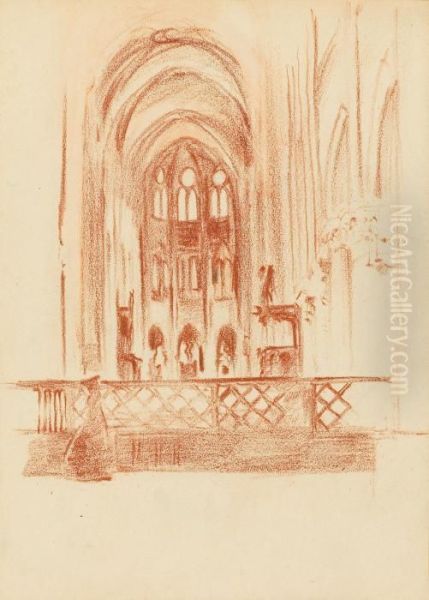
Furthermore, Carles received guidance from Cecilia Beaux, one of the foremost portrait painters of her era, celebrated for her elegant and psychologically insightful depictions. Perhaps most significantly, he studied under William Merritt Chase, a charismatic teacher and a leading proponent of American Impressionism, known for his bravura brushwork and emphasis on capturing light and atmosphere. This diverse training provided Carles with a strong technical foundation in academic drawing and painting, even as it exposed him to the burgeoning influence of Impressionism. His talent was recognized early on, earning him prestigious awards, including the Cresson Traveling Scholarships in 1903 and 1907, which enabled him to pursue his studies abroad.
Paris: The Crucible of Modernism
The Cresson Traveling Scholarships afforded Carles the invaluable opportunity to travel to Europe, and like many ambitious American artists of his generation, he was drawn irresistibly to Paris. He first traveled in 1905 and returned for a longer, more formative stay beginning in 1907, remaining based there, with trips back to the US, until around 1912, though he continued to visit later. Paris in these years was the undisputed epicenter of the avant-garde, a melting pot of radical artistic ideas and experimentation.
Carles immersed himself in this stimulating environment. He frequented the Louvre, studying the Old Masters, but was profoundly impacted by the contemporary art he encountered. He was particularly captivated by the work of the Post-Impressionists, above all Paul Cézanne. Cézanne's rigorous analysis of form, his structured compositions, and his use of color to build volume resonated deeply with Carles and would remain a touchstone throughout his career.
Equally significant was his encounter with the Fauves, particularly Henri Matisse. The Fauvist liberation of color, using it arbitrarily and expressively rather than descriptively, thrilled Carles. He admired Matisse's bold compositions, decorative patterning, and sensual lines. This exposure encouraged Carles to experiment with increasingly intense palettes and freer brushwork, moving decisively away from the more restrained tones of American Impressionism.
During his time in Paris, Carles moved within expatriate artistic circles. He formed important friendships with fellow American modernists, including the watercolorist John Marin, known for his dynamic depictions of urban and natural landscapes, and the photographer and painter Edward Steichen. Steichen, who was closely associated with Alfred Stieglitz's gallery back in New York, became a key contact. Carles also reportedly met the aging Impressionist master Edgar Degas. These interactions and the overall artistic ferment of Paris fundamentally shaped Carles's artistic vision, pushing him towards a modernism defined by expressive color and increasingly abstract forms. He absorbed the lessons of French painting but began to synthesize them into his own burgeoning style.
Championing Modernism in Philadelphia
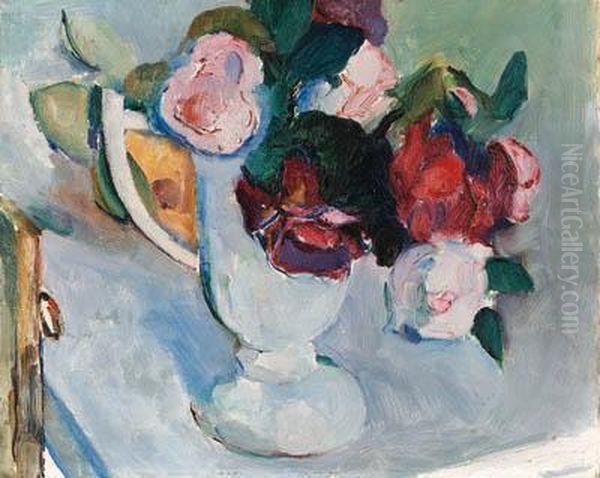
Upon his return to the United States, Carles settled primarily in Philadelphia, although he maintained connections with the New York art world. He became a central figure in the city's small but growing modernist circle, acting as both an artist and an advocate for the new art forms emerging from Europe. Philadelphia, while possessing venerable institutions like PAFA, was generally more conservative artistically than New York, making Carles's role particularly significant.
From 1917 to 1925, Carles taught painting at PAFA, his alma mater. In this capacity, he influenced a new generation of Philadelphia artists, sharing his enthusiasm for modern European art and encouraging experimentation. His teaching methods, likely informed by his own experiences and his admiration for expressive techniques, would have offered a counterpoint to more traditional instruction. He became known for his charismatic, if sometimes volatile, personality.
Beyond teaching, Carles actively worked to promote modernism. He played a key role in organizing exhibitions that introduced challenging contemporary art to Philadelphia audiences. A notable, and controversial, instance occurred in 1923 when Carles, along with his former teacher Henry McCarter, persuaded the formidable collector Dr. Albert C. Barnes to exhibit works from his unparalleled collection of modern French art at PAFA. The exhibition, featuring masterpieces by Cézanne, Matisse, Pablo Picasso, and others, was met with public ridicule and critical hostility, reinforcing Barnes's subsequent reluctance to allow public access to his collection for decades. This event underscores both Carles's commitment to the avant-garde and the resistance modern art faced in America at the time.
Carles also maintained his New York connections, exhibiting at Alfred Stieglitz's progressive '291' gallery as early as 1910 in the "Younger American Painters" show and having a solo exhibition there in 1912. He was part of the Stieglitz circle, a group of American modernists championed by the influential photographer and gallerist. This network included artists like Georgia O'Keeffe, Marsden Hartley, and Arthur Dove. Carles's participation in landmark exhibitions, such as the 1913 Armory Show (officially the International Exhibition of Modern Art), further cemented his place within the burgeoning American modernist movement.
The Evolution of a Colorist
Arthur B. Carles is perhaps best remembered as a masterful colorist. Throughout his career, his exploration of color – its emotional power, its structural possibilities, its sheer sensuous appeal – remained paramount. His stylistic evolution can be traced through his increasingly bold and experimental use of color and form, moving from early works influenced by Impressionism towards a unique form of expressive abstraction.
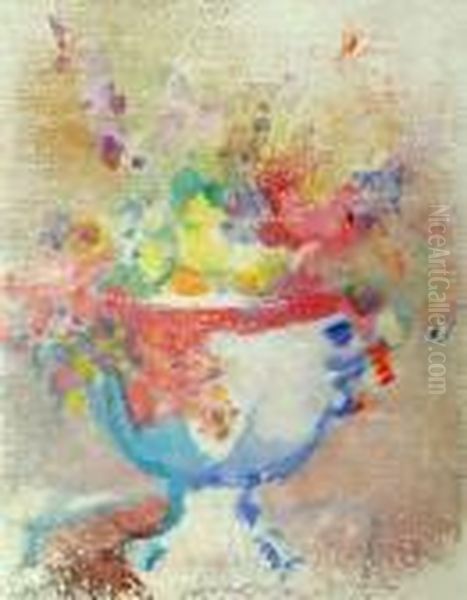
In his works from the 1910s and early 1920s, the influence of French Post-Impressionism and Fauvism is evident. He employed vibrant, often non-naturalistic colors and applied paint with a visible energy and freedom. His brushwork became increasingly loose and gestural, defining forms while simultaneously emphasizing the materiality of the paint itself. Still lifes and nudes became favorite subjects, providing frameworks for his formal investigations.
Carles believed that color could be the primary structuring element of a painting. He explored harmonies and dissonances, using color relationships to create depth, suggest volume, and evoke mood. His approach shared affinities with Synchromism, an early American abstract movement founded by Stanton Macdonald-Wright and Morgan Russell, which sought to create form and rhythm purely through color, analogous to music. While not a formal member, Carles exhibited alongside Synchromist artists and clearly shared their interest in the structural and expressive potential of color.
By the late 1920s and into the 1930s, Carles's work moved towards greater abstraction. Forms became more fragmented, influenced perhaps by Cubism, particularly the work of Picasso and Georges Braque. However, unlike the often-muted palette of analytical Cubism, Carles never abandoned his commitment to rich, saturated color. His abstractions often retained a connection to observed reality – a floral arrangement, a figure – but these subjects were transformed through dynamic compositions of swirling color and energetic lines. Some critics noted his departure from the more analytical structure of French Cubism, finding his approach more intuitive and chromatically driven.
His late works, created in the years leading up to his debilitating accident, represent the culmination of his explorations. Paintings like Abstraction (Last Painting) (c. 1936-1941) are powerful statements of pure color and gesture, anticipating the energy and scale of Abstract Expressionism, which would emerge in the following decade. Carles pushed the boundaries of painting, using color and form to convey intense emotion and vitality.
Signature Works
Several key works exemplify Arthur B. Carles's artistic development and his mastery of color.
_L'Eglise_ (c. 1910): An early example from his time in France, this painting of a church likely in Voulangis, shows the clear influence of Cézanne in its structured composition and faceted brushwork, yet incorporates a brighter, more Impressionist-influenced palette than Cézanne typically used. It demonstrates Carles's process of absorbing and adapting European models.
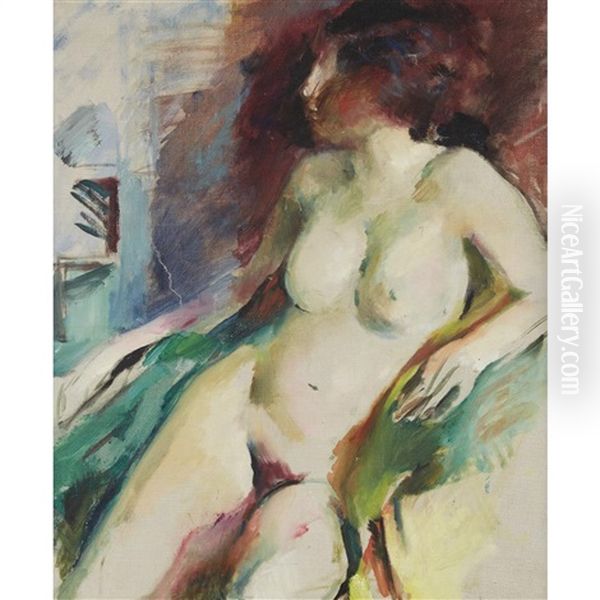
_Interior_ (c. 1910): Also from his Paris period, this work reveals the impact of Fauvism, particularly Matisse and perhaps the Nabis painters like Pierre Bonnard and Édouard Vuillard. The flattened space, decorative patterns, and bold color choices signal his move away from academic realism towards expressive modernism.
_Red Haired Woman_ (also known as _Woman with Red Hair_ or _Portrait of Vera_ ) (1922): This striking portrait is one of Carles's most celebrated works. It embodies his fascination with Fauvist color and expressive brushwork. The subject's hair is rendered in vibrant, almost electric reds and oranges, set against contrasting cool tones in the background and her clothing. The application of paint is bold and direct, conveying a sense of immediacy and psychological intensity. It reflects Carles's deep engagement with the work of Matisse while asserting his own powerful style.
_Still Life with Flowers_ (various dates): Carles returned frequently to the still life genre, using arrangements of flowers, fruit, and drapery as vehicles for his experiments with color and form. Works like Narcissus or Flowers in a Vase (now at SFMOMA) showcase his ability to transform ordinary objects into dynamic compositions. He often employed high-keyed colors, complex spatial arrangements that flirted with abstraction, and energetic brushwork that made the entire canvas vibrate with life. These still lifes are considered among his finest achievements and demonstrate his reputation as a preeminent colorist.
_Nude_ (various dates, e.g., _Green Nude_): Carles painted numerous nudes throughout his career, often using the figure as a starting point for radical formal and chromatic exploration. Works like Green Nude exemplify his move towards abstraction. The figure is simplified, distorted, and rendered in non-naturalistic colors – greens, blues, reds – applied with vigorous, almost raw, brushstrokes. The emphasis is less on anatomical accuracy and more on expressive power and the interplay of color and form, pushing towards the abstract compositions of his later years.
_Abstraction (Last Painting)_ (c. 1936-1941): This title is often given to one of the powerful abstract works Carles was creating just before his accident. These paintings are characterized by swirling, dynamic compositions of pure color and gesture. Recognizable forms dissolve into energetic fields of paint, demonstrating Carles's arrival at a fully non-representational style that anticipates Abstract Expressionism. They possess a raw energy and chromatic brilliance that represent the culmination of his lifelong artistic quest.
Networks, Relationships, and Controversies
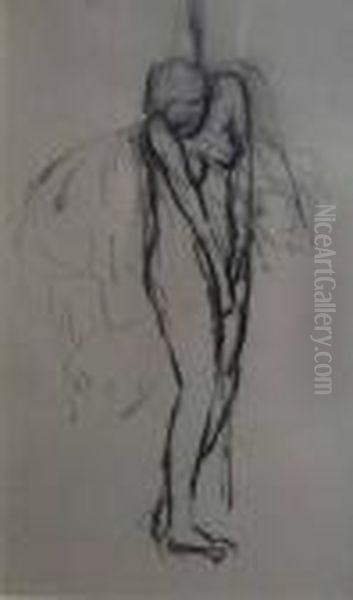
Arthur B. Carles operated within a complex web of relationships that shaped his career and reception. His connections spanned continents and encompassed fellow artists, influential dealers, collectors, and institutions.
His time in Paris was crucial for building relationships with fellow American expatriates like John Marin and Edward Steichen. Steichen, in particular, provided a vital link to Alfred Stieglitz's avant-garde circle in New York. Stieglitz's '291' gallery was the premier venue for modern art in America, and Carles's inclusion in its exhibitions provided him with crucial visibility and validation early in his career. The Stieglitz circle fostered a sense of shared purpose among American artists seeking to define a native modernism, even amidst diverse individual styles. Carles benefited from this association, exhibiting alongside pioneers like Marsden Hartley, Arthur Dove, and Georgia O'Keeffe.
Back in Philadelphia, Carles was a central, if sometimes contentious, figure. His teaching position at PAFA placed him in contact with younger artists, such as Franklin Watkins, whom he influenced. His relationship with the institution itself was complex; while it provided him with training and later employment, its generally conservative stance often clashed with his modernist advocacy. The 1923 Barnes exhibition controversy exemplifies this tension. Carles's alliance with Henry McCarter in persuading Dr. Albert C. Barnes to show his collection was a bold move to inject radical European art into the Philadelphia scene, but the hostile public and critical reaction highlighted the city's resistance and ultimately strained relations, particularly for Barnes.
Carles's personality, often described as charismatic, passionate, but also volatile and prone to bouts of heavy drinking, likely impacted his professional relationships. While admired for his talent and dedication by many, his temperament may have contributed to periods of instability or friction within the art community.
His engagement with European masters like Cézanne and Matisse was primarily one of deep study and adaptation rather than direct personal mentorship, although he did meet figures like Degas. His relationship with Cubism, particularly Picasso and Braque, was more complex. While he incorporated Cubist fragmentation into his later work, his emphasis remained on color, leading some critics to find his approach less rigorous or structurally innovative than that of the Parisian originators. Nonetheless, these European artists remained constant points of reference and inspiration throughout his career.
Navigating Art Movements
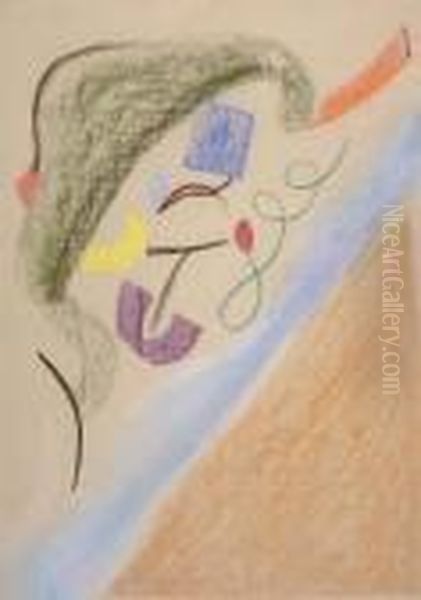
Arthur B. Carles's career cannot be neatly confined to a single art movement; rather, he navigated and synthesized elements from several key styles of the early twentieth century, forging a distinctive artistic identity.
His initial training was grounded in the academic realism prevalent at PAFA, but he quickly absorbed the lessons of Impressionism, particularly through the influence of William Merritt Chase and his own experiences in France. This is visible in his early attention to light, atmosphere, and broken brushwork.
However, Carles soon moved beyond Impressionism, embracing the bolder palette and expressive freedom of Fauvism. The influence of Matisse is undeniable in Carles's work from the 1910s and 1920s, particularly in his use of intense, non-naturalistic color and flattened, decorative compositions. He became a leading American exponent of this color-driven modernism.
Carles's work also shows an engagement with Cubism, especially in his later paintings from the late 1920s and 1930s. He adopted the fragmented forms and shifting perspectives characteristic of the style, breaking down objects and figures into geometric planes. Yet, he infused Cubist structure with his signature vibrant color, creating a more expressive and less analytical variant than its French counterpart.
His emphasis on color as the primary means of expression and structure aligns his work with the principles of Synchromism, the movement founded by Stanton Macdonald-Wright and Morgan Russell. Although not a formal member of the group, Carles exhibited with them and shared their belief in the potential of color to create form, rhythm, and emotion, akin to music.
Most significantly, Carles is now widely recognized as a crucial precursor to Abstract Expressionism. His late abstract paintings, with their energetic gestural brushwork, emphasis on the materiality of paint, and large-scale chromatic fields, clearly anticipate the developments that would dominate American art in the 1940s and 1950s. Artists like Hans Hofmann, whose teachings were influential for the Abstract Expressionists, admired Carles's work. Carles's pioneering exploration of expressive abstraction laid important groundwork for the next generation. He stands as a key figure in American Modernism, embodying its transition from European-influenced styles to increasingly independent and abstract forms of expression.
Exhibition Highlights
Arthur B. Carles's work was presented in numerous significant exhibitions throughout his career, marking his presence in the evolving landscape of American modern art.
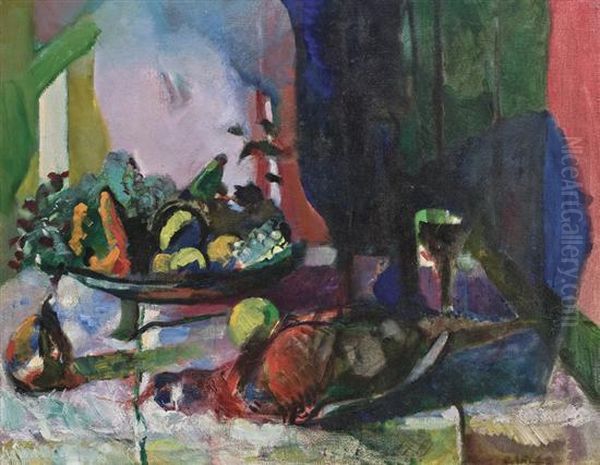
His early connection with Alfred Stieglitz led to important showings at the '291' gallery in New York. He was included in the group exhibition "Younger American Painters" in 1910 and had a solo exhibition there in 1912. These exhibitions placed him firmly within the American avant-garde circle promoted by Stieglitz.
In 1913, Carles participated in the landmark International Exhibition of Modern Art, better known as the Armory Show, held in New York City, Chicago, and Boston. This massive exhibition controversially introduced large audiences in America to European modernism (including works by Matisse, Picasso, Duchamp) alongside contemporary American art. Carles's inclusion signaled his recognition as part of this new wave.
He regularly exhibited at the annual exhibitions of the Pennsylvania Academy of the Fine Arts, maintaining a presence in his home city's premier art institution, despite the sometimes conservative nature of these shows.
In 1927, Carles was one of seven artists featured in the "Philadelphia Modernists" exhibition held at the Wildenstein Gallery in New York. This show highlighted the distinct modernist activity centered in Philadelphia, with Carles as a leading figure.
Throughout the 1920s and 1930s, his work was shown in various galleries and group exhibitions focusing on American modernism. Although his output ceased after 1941, his work gained renewed attention posthumously.
A major retrospective exhibition, "Arthur B. Carles: Painting with Color," was organized by the Pennsylvania Academy of the Fine Arts in 1983. This exhibition, accompanied by a significant catalogue, played a crucial role in reassessing Carles's contribution and solidifying his reputation as a major figure in American modernism and a pioneer of abstract painting. Subsequent exhibitions at various institutions have continued to explore his legacy.
A Career Cut Short
Arthur B. Carles's artistic journey, marked by intense exploration and chromatic brilliance, came to an abrupt and tragic end. In December 1941, while reportedly suffering from the effects of alcoholism, Carles experienced a severe fall, possibly down a flight of stairs. The accident resulted in permanent paralysis, leaving him unable to paint for the remainder of his life.
This event occurred at a time when Carles was arguably at the height of his artistic powers, deeply engaged in creating powerful abstract compositions that pushed the boundaries of American painting. The sudden cessation of his work represents a significant loss, leaving art historians to speculate on the directions his art might have taken had he been able to continue. The decade following his accident saw the rise of Abstract Expressionism, a movement his late work clearly anticipated.
Carles lived for another decade after the accident, passing away in 1952 at the age of 70. His final years were spent incapacitated, unable to participate actively in the art world that was increasingly embracing the abstract modes he had helped to pioneer. This tragic end adds a poignant dimension to his life story, highlighting the personal struggles that often accompanied the creative drive of modernist artists.
Legacy and Collections
Despite the premature end to his painting career and periods of relative obscurity, Arthur B. Carles has secured a significant place in the history of American art. His primary legacy lies in his role as a pioneering modernist and an exceptional colorist. He was instrumental in introducing and adapting European avant-garde ideas, particularly Fauvism and Cubism, for an American context, especially within Philadelphia.
His unwavering commitment to the expressive power of color distinguishes his work. He demonstrated that color could be more than descriptive; it could be the fundamental structure and emotional core of a painting. In this, he served as an important bridge between the first wave of American modernism influenced by Europe and the later development of Abstract Expressionism. While direct influence can be hard to trace definitively, the chromatic intensity and gestural freedom of his late abstractions resonate strongly with the work of Abstract Expressionists like Hans Hofmann (who knew and admired Carles's work) and Willem de Kooning.
As an influential teacher at PAFA, Carles impacted a generation of Philadelphia artists, fostering an environment more receptive to modernism. His advocacy, including the controversial Barnes exhibition, demonstrated his commitment to challenging conservative tastes.
Today, Arthur B. Carles's works are held in the collections of major American museums, ensuring his continued visibility. Key institutions include:
Philadelphia Museum of Art: Holds a significant collection, reflecting his importance to the city.
Pennsylvania Academy of the Fine Arts (PAFA): His alma mater and former employer, holds important works and archival material.
Woodmere Art Museum (Philadelphia): Has a strong focus on Philadelphia artists and holds a substantial collection of Carles's work, frequently featuring it in exhibitions.
Hirshhorn Museum and Sculpture Garden (Washington, D.C.)
San Francisco Museum of Modern Art (SFMOMA)
Metropolitan Museum of Art (New York)
Whitney Museum of American Art (New York)
His paintings also reside in numerous private collections, testament to his enduring appeal. Scholarly publications and retrospective exhibitions continue to explore and affirm his contribution, recognizing Arthur B. Carles not just as a Philadelphia modernist, but as a vital and innovative force in the broader narrative of twentieth-century American art.
Conclusion
Arthur Beecher Carles remains a compelling figure in American art history – a painter whose career burned brightly with chromatic intensity and a dedication to modernist principles. From his rigorous training at PAFA to his transformative experiences in avant-garde Paris, and his subsequent role as a teacher and advocate in Philadelphia, Carles consistently pushed artistic boundaries. His genius lay in his intuitive and sophisticated understanding of color, which he wielded with expressive force, creating works that ranged from vibrant figurative paintings to dynamic, near-total abstractions. Though his career was tragically cut short, his legacy endures. He stands as a crucial link between early European modernism and the rise of American abstract art, a testament to the power of individual vision in shaping the course of art history. His paintings continue to captivate viewers with their vitality, complexity, and sheer beauty, securing his position as one of America's most significant early modernists.